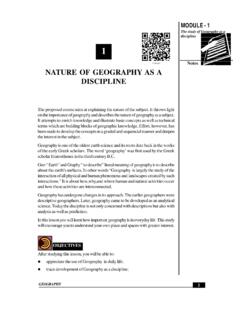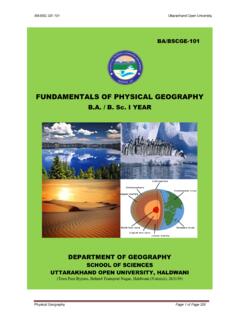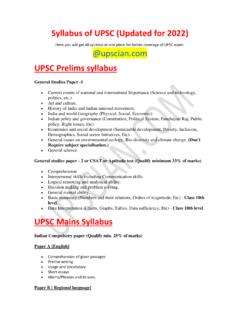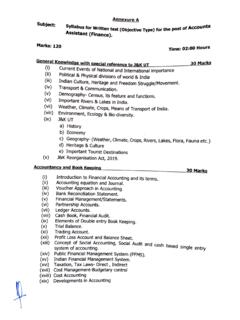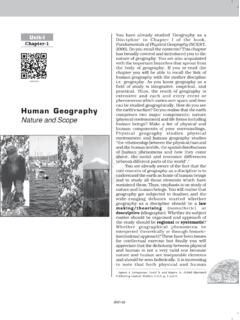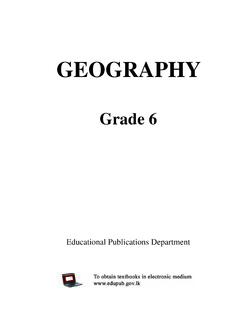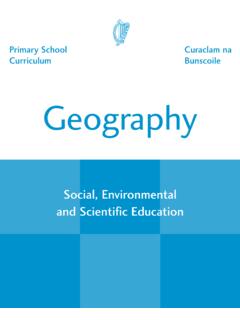Transcription of Subject specific vocabulary - AQA
1 Subject specific vocabulary All terms stated in the specification can be used in the exam. Students should be familiar with, and gain some understanding of, these terms in relation to the topics that they study. The required terms are listed below under each of the topic headings. Note that each list includes only the geographical terms stated in the specification. Students are encouraged to use other specialist geographical vocabulary in their answers as well as the terms listed here. Low income country (LIC) and High income country (HIC) This subdivision of countries is based on the World Bank income classifications (GNI per capita), which in 2013 were Low Income $1045 or below, and High Income $12746 or above.
2 Newly emerging economies (NEEs) Countries that have begun to experience higher rates of economic development, usually with higher levels of industrialisation. They differ from LICs in that they no longer rely primarily on agriculture, have made gains in infrastructure and industrial growth, and are experiencing increasing incomes and high levels of investment, eg Brazil, Russia, China and South Africa (the so-called BRICS countries). Section A: The challenge of natural hazards Natural hazards Hazard risk The probability or chance that a natural hazard may take place. Natural hazard A natural event (for example an earthquake, volcanic eruption, tropical storm, flood) that threatens people or has the potential to cause damage, destruction and death.
3 Tectonic hazards Conservative plate margin Tectonic plate margin where two tectonic plates slide past each other. Constructive plate margin Tectonic plate margin where rising magma adds new material to plates that are diverging or moving apart. Destructive plate margin Tectonic plate margin where two plates are converging or coming together and oceanic plate is subducted. It can be associated with violent earthquakes and explosive volcanoes. Earthquake A sudden or violent movement within the Earth s crust followed by a series of shocks. Immediate responses The reaction of people as the disaster happens and in the immediate aftermath. Long-term responses Later reactions that occur in the weeks, months and years after the event.
4 Monitoring Recording physical changes, such as earthquake tremors around a volcano, to help forecast when and where a natural hazard might strike. Plate margin The margin or boundary between two tectonic plates. Planning Actions taken to enable communities to respond to, and recover from, natural disasters, through measures such as emergency evacuation plans, information management, communications and warning systems. Prediction Attempts to forecast when and where a natural hazard will strike, based on current knowledge. This can be done to some extent for volcanic eruptions (and tropical storms), but less reliably for earthquakes. Primary effects The initial impact of a natural event on people and property, caused directly by it, for instance the ground buildings collapsing following an earthquake.
5 Protection Actions taken before a hazard strikes to reduce its impact, such as educating people or improving building design. Secondary effects The after-effects that occur as indirect impacts of a natural event, sometimes on a longer timescale, for instance fires due to ruptured gas mains resulting from the ground shaking. Tectonic hazard A natural hazard caused by movement of tectonic plates (including volcanoes and earthquakes). Tectonic plate A rigid segment of the Earth s crust which can float across the heavier, semi-molten rock below. Continental plates are less dense, but thicker than oceanic plates. Volcano An opening in the Earth s crust from which lava, ash and gases erupt. Weather hazards Economic impact The effect of an event on the wealth of an area or community.
6 Environmental impact The effect of an event on the landscape and ecology of the surrounding area. Extreme weather This is when a weather event is significantly different from the average or usual weather pattern, and is especially severe or unseasonal. This may take place over one day or a period of time. A severe snow blizzard or heat wave are two examples of extreme weather in the UK. Global atmospheric circulation The worldwide system of winds, which transports heat from tropical to polar latitudes. In each hemisphere, air also circulates through the entire depth of the troposphere which extends up to 15 km. Immediate responses The reaction of people as the disaster happens and in the immediate aftermath.
7 Long-term responses Later reactions that occur in the weeks, months and years after the event. Management strategies Techniques of controlling, responding to, or dealing with an event. Monitoring Recording physical changes, such as tracking a tropical storm by satellite, to help forecast when and where a natural hazard might strike. Planning Actions taken to enable communities to respond to, and recover from, natural disasters, through measures such as emergency evacuation plans, information management, communications and warning systems. Prediction Attempts to forecast when and where a natural hazard will strike, based on current knowledge. This can be done to some extent for tropical storms (and volcanic eruptions, but less reliably for earthquakes).
8 Primary effects The initial impact of a natural event on people and property, caused directly by it, for instance buildings being partially or wholly destroyed by a tropical storm. Protection Actions taken before a hazard strikes to reduce its impact, such as educating people or improving building design. Secondary effects The after-effects that occur as indirect impacts of a natural event, sometimes on a longer timescale, for instance impact on access to potable water can lead to spread of disease. Social impact The effect of an event on the lives of people or community. Tropical storm (hurricane, cyclone, typhoon) An area of low pressure with winds moving in a spiral around the calm central point called the eye of the storm.
9 Winds are powerful and rainfall is heavy. Climate change Adaptation Actions taken to adjust to natural events such as climate change, to reduce potential damage, limit the impacts, take advantage of opportunities, or cope with the consequences. Climate change A long-term change in the earth's climate, especially a change due to an increase in the average atmospheric temperature. Mitigation Action taken to reduce or eliminate the long-term risk to human life and property from natural hazards, such as building earthquake-proof buildings or making international agreements about carbon reduction targets. Orbital changes Changes in the pathway of the Earth around the Sun. Quaternary period The period of geological time from about million years ago to the present.
10 It is characterized by the appearance and development of humans and includes the Pleistocene and Holocene Epochs. Section B: The living world Ecosystems Abiotic Relating to non-living things. Biotic Relating to living things. Consumer Creature that eats animals and/or plant matter. Decomposer An organism such as a bacterium or fungus, that breaks down dead tissue, which is then recycled to the environment. Ecosystem A community of plants and animals that interact with each other and their physical environment. Food chain The connections between different organisms (plants and animals) that rely on one another as their source of food. Food web A complex hierarchy of plants and animals relying on each other for food.










